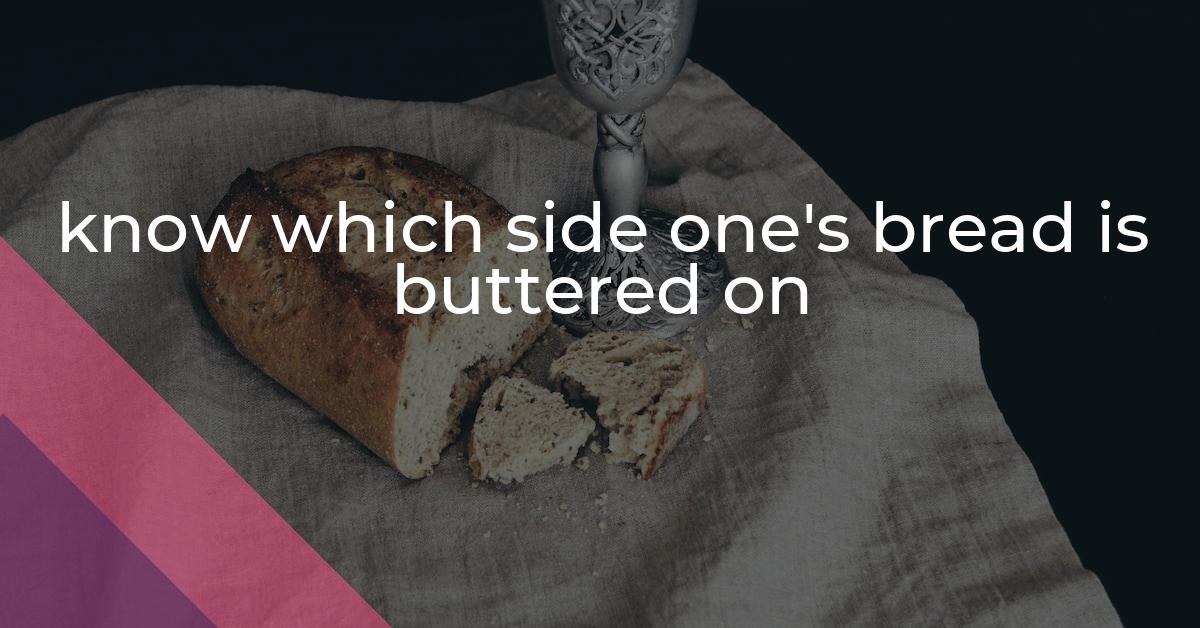know which side one’s bread is buttered on: Idiom Meaning and Origin
What does ‘know which side one's bread is buttered on’ mean?
The idiom *know which side one's bread is buttered on* means to understand where one's interests lie and to act accordingly in order to benefit oneself or to avoid negative consequences. It suggests being aware of the people or situations that can provide advantages and acting in a way that maintains or strengthens those advantages.

Idiom Explorer
The idiom "know which end is up" means to have basic knowledge or understanding of a situation or task.
The idiom "know what is what" means to have a clear understanding or knowledge of a situation or topic. It implies being well-informed and aware of the essential facts or details, allowing one to make informed decisions or judgments.
The idiom "know the score" means to understand and be aware of the situation or the facts.
The idiom "know one's way around" means to be familiar with or knowledgeable about a particular place, task, or subject.
The idiom "know one's shit" means to be very knowledgeable or well-informed about a particular subject or topic. It implies a deep understanding and expertise in that area.
The idiom "know one's own mind" means to have a clear and definite opinion or decision about something. It implies being confident and decisive in one's thoughts and choices.
The idiom "know one's ass from a hole in the ground" means to have no basic knowledge or understanding about a specific topic or situation.
Idiom: know inside and out
Meaning: To know something very well or fully understand it
The idiom "know every trick in the book" means to be knowledgeable and experienced in all the methods, techniques, or strategies related to a particular subject or activity.
Bread's buttered side: A Key to Success
The idiom "know which side one's bread is buttered on" is a common English expression that conveys the idea of being aware of one's self-interests and acting accordingly. It is used to describe someone who understands where their advantage lies and behaves in a way that benefits them. The origin of this idiom can be traced back to the practice of buttering bread, a culinary custom that has been around for centuries. While the exact origin of the phrase is uncertain, its meaning and usage have remained consistent over time.
One interpretation of the idiom suggests that it originated from the practice of buttering one side of the bread before eating it, as it is more enjoyable to consume. By knowing which side of the bread is buttered, one ensures that they are getting the best, most satisfying part of the meal. This can be seen as a metaphorical representation of understanding one's own interests and making decisions accordingly.
Additionally, the idiom can also be linked to the custom of serving bread with butter as a sign of hospitality and goodwill. In this context, the act of knowing which side of the bread is buttered on can be seen as recognizing and appreciating the gestures of kindness and support from others. By acknowledging and reciprocating these actions, individuals can strengthen their relationships and secure their own benefits.
Furthermore, the idiom "know which side one's bread is buttered on" often implies a level of shrewdness and pragmatism. It suggests that the person understands the dynamics of a situation and is capable of making calculated choices to maximize their own advantages. This can be particularly relevant in professional settings, where being aware of power dynamics and aligning oneself with influential figures can lead to career advancement and success.
The idiom "butter one's bread on both sides" is related to "know which side one's bread is buttered on," and it refers to someone who seeks to benefit from both sides of a situation or relationship. While "know which side one's bread is buttered on" emphasizes understanding one's own interests, "butter one's bread on both sides" highlights the ability to capitalize on multiple opportunities for personal gain.
Sometimes, individuals must navigate complex situations where it is not immediately apparent which actions or choices would be most advantageous. In these circumstances, it is important to "know what is what" and understand the true nature of the situation. By being well-informed and discerning, individuals can make decisions that align with their interests and maximize their benefits.
Another related idiom, "know one's way around," emphasizes familiarity and expertise in a particular domain. Just as one must know which side of the bread is buttered on to benefit from it, knowing one's way around allows individuals to navigate a specific field or environment with confidence and competence. This expertise can be instrumental in identifying and seizing opportunities for personal gain.
Furthermore, the idiom "bread and butter" refers to the basic necessities or the main source of income or support. Understanding which side one's bread is buttered on plays a crucial role in securing one's bread and butter. By recognizing and focusing on the aspects that sustain them financially or personally, individuals can ensure their stability and success.
Lastly, the idiom "know which end is up" reflects the importance of clarity and understanding. Just as one must know which side of the bread is buttered on to enjoy the best part of the meal, knowing which end is up allows individuals to grasp the situation and make informed decisions to their advantage. In a chaotic or confusing context, being able to identify the right path or course of action is essential for achieving favorable outcomes.
Overall, the proverbial expression "know which side one's bread is buttered on" is a valuable idiom that encapsulates the importance of recognizing and pursuing one's interests. By understanding where one's advantages lie and acting accordingly, individuals can navigate various situations more effectively and secure their own success. Whether it is by capitalizing on opportunities, understanding complex dynamics, or appreciating acts of kindness and support, knowing which side one's bread is buttered on can lead to personal and professional growth. So, as you move through life, remember to always know which side your bread is buttered on!
Example usage
Examples of how the idiom "know which side one's bread is buttered on" can be used in a sentence:
- He knows which side his bread is buttered on, so he always takes care not to offend his boss.
- She quickly realized which side her bread was buttered on and decided to support her influential friend in the election.
- When the employee saw the CEO's favor towards the new project, he knew which side his bread was buttered on and volunteered to lead the team.
More "Wisdom" idioms



